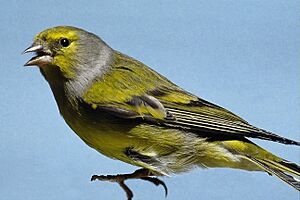Citril finch facts for kids
Quick facts for kids Citril finch |
|
|---|---|
 |
|
| Conservation status | |
| Scientific classification | |
| Genus: |
Carduelis
|
| Species: |
citrinella
|
| Synonyms | |
|
|
The citril finch (Carduelis citrinella) is a small, pretty songbird. It's also called the Alpine citril finch. This bird belongs to the true finch family, which is called Fringillidae. You can find these birds living in the mountains of southwestern Europe. They live from Spain all the way to the Alps. Their homes stretch north to the Black Forest in southwestern Germany.
Contents
What is a Citril Finch?
How Big Are They?
The citril finch is about 12 cm (4.7 in) long. That's about the length of a pen. It weighs around 12.5 g (0.44 oz). This is about the same as two quarters.
What Do They Look Like?
These birds are mostly grey on top. Their back has a brownish tint with black streaks. Their belly and the stripes on their wings are bright yellow. They also have a bright yellow face mask. Both male and female citril finches look quite similar. Young females might be a bit duller in color. Young birds are brown and don't have any yellow or green feathers.
What Do They Sound Like?
The song of the citril finch sounds like a silvery twittering. It's similar to the song of the European goldfinch. It also sounds a bit like the European serin. Their main call is a "tee-ee" sound. This call is quite like the one made by the Eurasian siskin.
Where Do Citril Finches Live?
Citril finches love to live in subalpine conifer forests. These are forests with trees like pines and spruces. They also live in Alpine meadows. These birds build their nests mainly in pine and spruce trees.
There is another type of finch, the Corsican finch. It lives on islands and can be found in many different places. But the mainland citril finch prefers specific mountain habitats.
Why Are They Called That?
The citril finch was first officially described in 1764. A German scientist named Peter Simon Pallas gave it the scientific name Fringilla citrinella. The name Carduelis comes from a Latin word. It means "European goldfinch". The second part, citrinella, is an Italian word. It means "small yellow bird". This name fits because "citrinus" in Latin means light greenish-yellow.
The Corsican finch was once thought to be the same species. But now scientists know it is a separate species. Studies have shown that the citril finch is closely related to the European goldfinch.
Are They Safe?
The citril finch is found in many places. Because of this, the IUCN lists it as a species of Least Concern. This means that there are plenty of them around. They are not currently at risk of disappearing.



